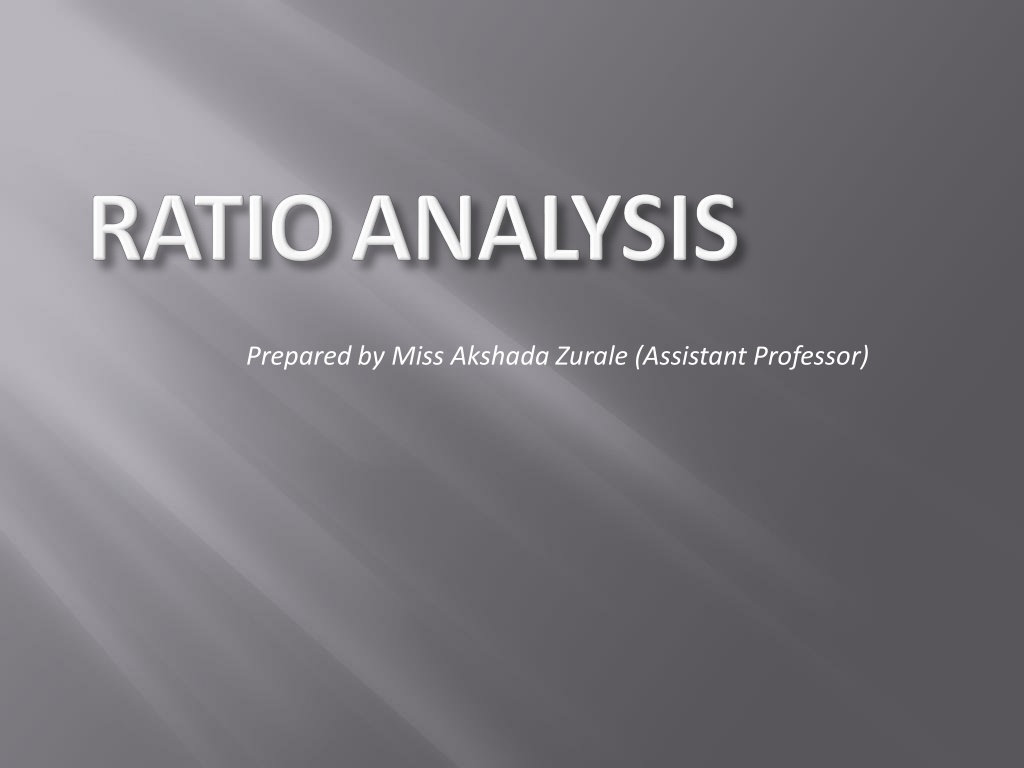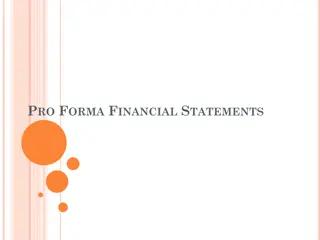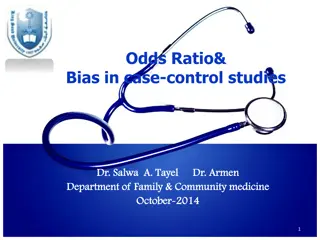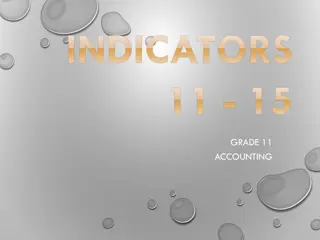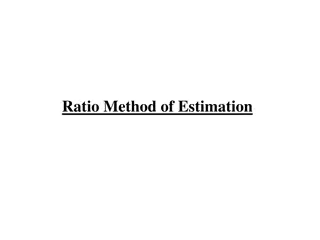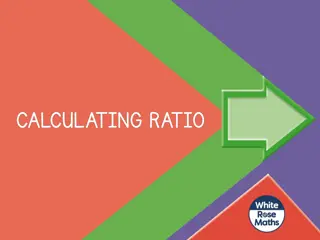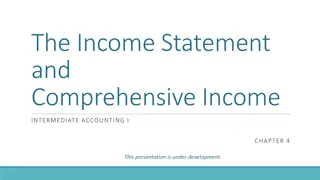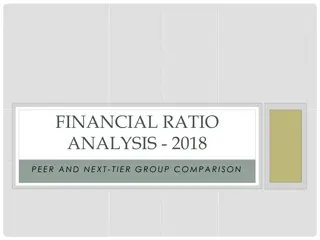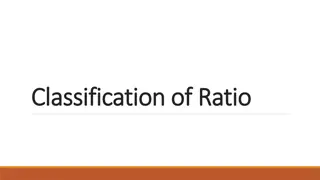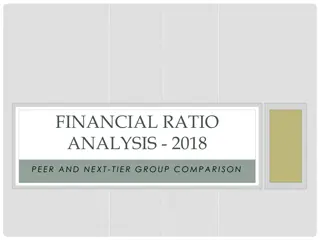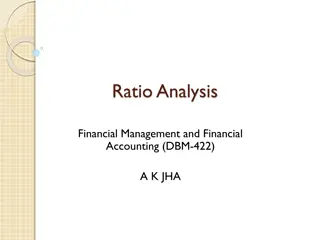Understanding Ratio Analysis in Financial Statements
Ratio analysis is a crucial process in interpreting financial statements by deriving accounting ratios from the balance sheet and profit and loss account. It involves assessing short-term liquidity, long-term solvency, activity ratios, and profitability ratios. Liquidity ratios like current ratio, quick ratio, and absolute liquid ratio help evaluate a company's ability to meet short-term obligations. These ratios provide insights into working capital management, shareholder dividends, and creditor interests.
Download Presentation

Please find below an Image/Link to download the presentation.
The content on the website is provided AS IS for your information and personal use only. It may not be sold, licensed, or shared on other websites without obtaining consent from the author. Download presentation by click this link. If you encounter any issues during the download, it is possible that the publisher has removed the file from their server.
E N D
Presentation Transcript
Ratio analysis is the process of determining and interpreting numerical relationship based on financial statements. It is the technique of interpretation of financial statements with the help of accounting ratios derived from the balance sheet and profit and loss account.
Analysis of Short Term Financial Position or Test of Liquidity. Analysis of Long Term Financial Position or Test of Solvency. Activity Ratios. Profitability Ratios.
The liquidity ratios are used to test the short term solvency or liquidity position of the business. It enables to know whether short term liabilities can be paid out of short term assets. It is a valuable aid to management in checking the efficiency with which working capital is being employed. It is also of importance to shareholders and long term creditors in determining to some extent the prospects of dividend and interestpayment.
Current ratio. Quick ratio. Absolute liquidratio.
It is the most widely used of all analytical devices based on the balance sheet. It establishes relationship between total current assets and current liabilities. Current assets Current ratio= Current liabilities Ideal ratio: 2:1 High ratio indicates under trading and over capitalization. Low ratio indicates over trading and under capitalization.
It establishes relationship between liquid assets and liquid liabilities. It is a refinement to current ratio and second testing device for working capital. Quick assets Quick ratio= Current liabilities Ideal ratio: 1:1 Usually, a high acid test ratio is an indication that the firm is liquid and has ability to meet its current or liquid liabilities in time and on the other hand a low quick ratio represents that the firm s liquidity position is not good.
This ratio establishes a relationship between absolute liquid assets to quick liabilities. Absolute liquid assets Absolute liquid ratio= Quick liabilities Ideal ratio: 1:2 It means that if the ratio is 1:2 or more than this the concern can be taken as liquid. If the ratio is less than the standard of 1:2, it means the concern is not liquid.
Long term solvency ratios denote the ability of the organization to repay the loan and interest. When an organization's assets are more than its liabilities is known as solvent organization. Solvency indicates that position of an enterprise where it is capable of meeting long term obligations.
Debt-equity ratio. Proprietary ratio. Solvency ratio. Fixed assets to net worthratio. Fixed assets ratio Debt servicing ratio. Dividend coverage ratio.
It Is calculated to measure the relative claims of outsiders and the owners against the firm s assets. This ratio indicates the relationship between the outsiders funds and the shareholders funds. Outsiders funds Debt equity ratio= Shareholders funds Ideal ratio: 2:1; It means for every 2 shares there is 1 debt. If the debt is less than 2 times the equity, it means the creditors are relatively less and the financial structure is sound.
It establishes relationship between the proprietors fund or shareholders funds and the total assets Proprietary funds Proprietary ratio= Total assets Ideal ratio: 0.5:1 Higher the ratio better the long term solvency (financial) position of the company.
It expresses the relationship between total assets and total liabilities of a business. This ratio is a small variant of equity ratio and can be simply calculated as 100-equity ratio . Total assets Solvency ratio= Total liabilities No standard ratio is fixed in this regard. Higher the solvency ratio, the stronger is its financial position and vice-versa.
It is obtained by dividing the depreciated book value of fixed assets by the amount of proprietors funds. Net fixed assets Fixed assets to net worth ratio= Net worth Ideal ratio: 0.75:1 A higher ratio, say, 100% means that there are no outside liabilities and all the funds employed are those of shareholders.
It establishes the relationship between fixed assets and capital employed Fixed assets Fixed assets ratio= Capital employed Ideal ratio: 0.67:1 This ratio enables to know how fixed assets are financed i.e. by use of short term funds or by long term funds. This ratio should not be more than 1.
This ratio is determined by dividing net profit by fixed interest charges. Debt Service Ratio = Net Profit Before Int & Tax Fixed Interest Charges Ideal ratio: 6 or 7 times; if the ratio is high it means there is higher margin of safety for the long term lenders and as such it is not difficult for the business to obtain further long term funds and vice-versa.
It is the ratio between disposable profit and dividend. Disposable profit refers to profit left over after paying interest on long term borrowing and income tax. Dividend Cover Ratio = Net Profit after Int & Tax Dividend Declared This ratio indicates the ability of the business to maintain the dividend on shares in future. If this ratio is higher is indicates that there is sufficient amount of retained profit.
Activity ratios indicate the performance of an organization. This indicate the effective utilization of the various assets of the organization. Most of the ratio falling under this category is based on turnover and hence these ratios are called as turnover ratios.
Stock turnover ratio. Debtors turnover ratio. Creditors turnover ratio. Wording capital turnoverratio. Fixed assets turnover ratio. Current assets turnover ratio. Total assets turnover ratio.
This ratio establishes the relationship between the cost of goods sold during a given period and the average sock holding during that period and indicates operational and marketing efficiency. Inventory turnover Ratio = COGS 100 Average Stock COGS = Sales Gross Profit = Opening Stock + Purchases -Closing Stock Average Stock = Opening Stock + Closing Stock 2
This ratio explains the relationship of net credit sales of a firm to its book debts indicating the rate at which cash is generated by turnover of receivables or debtors. Net credit sales Debtor turnover ratio= Average Debtors Opening balance + Closing balance Average debtors= 2
This ratio indicates the number of times the creditors are paid in a year. Net credit purchases Creditors turnover ratio= Average creditors Opening balance + closing balance Average creditors= 2 Number of working days Average payment period= Creditors turnover ratio
This ratio indicates the number of times the working capital is turned over in the course of the year. Measures efficiency in working capital usage. Cost of sales Working capital turnover ratio= Average working capital Opening + closing working capital Average working capital= 2
This ratio establishes a relationship between fixed assets and sales. Net sales Fixed assets turnover ratio= Fixed assets Ideal ratio: 5 times A high ratio indicates better utilization of fixed assets whereas a low ratio indicates under utilization of fixed assets.
This ratio establishes a relationship between total assets and sales. This ratio enables to know the efficient utilization of total assets of a business. Net sales Total assets turnover ratio= Total assets Ideal ratio: 2 times High ratio indicates efficient utilization and ratio less than 2 indicates under utilization.
Profitability ratios indicate the profit earning capacity of a business. Profitability ratios are calculated either in relation to sales or in relation to investments. Profitability ratios can be classified into two categories. a) General Profitability Ratios. b) Overall Profitability Ratios.
Gross profit ratio. Net profit ratio. Operating ratio. Operating profit ratio. Expense ratio.
It expresses the relationship of gross profit to net sales and is expressed in terms of percentage. This ratio is a tool that indicates the degree to which selling price of goods per unit may decline without resulting in losses. Gross Profit = Gross Profit 100 Net Sales A low gross profit ratio may indicate unfavorable purchasing, the instability of management to develop sales volume thereby making it impossible to buy goods in large volume.
It expresses the relationship between net profit after taxes to sales. Measure of overall profitability useful to proprietors, as it gibes an idea of the efficiency as well as profitability of the business to a limited extent. Net profit after taxes Net profit ratio= X 100 Net sales Higher the ratio better is the profitability.
This ratio establishes a relationship between cost of goods sold plus other operating expenses and net sales. This ratio is calculated mainly to ascertain the operational efficiency of the management in their business operations. Operating Ratio= COGS + Operating Exp Net Sales Higher the ratio the less favorable it is because it would leave a smaller margin to meet interest, dividend and other corporate needs. This ratio is partial index of over all profitability.
This ratio establishes the relationship between operation profit and net sales. Operating profit Operating profit ratio= X100 Net sales Operating profit ratio= 100-operating ratio Operating profit= Net sales ( cost of goods sold + Administrative and office expenses + selling and distributive expenses.
It establishes relationship between individual operation expenses and net sales revenue. Cost of Goods Sold Ratio = COGS Net Sales 100 Admin & Office Exp Ratio = Office & Admin Exp 100 Net Sales Selling & Distribution Exp Ratio = Selling & Distb Exp 100 Net Sales Non-Operating Exp Ratio = Non-Operating Exp 100 Net Sales
Return on shareholders investment or Net worth ratio. Return on equitycapital. Return on capitalemployed. Dividend yield ratio. Price covering ratio. Dividend pay out ratio. Earning per share.
Shareholders investment also called return on proprietor s funds is the ratio of net profit to proprietor s funds. It is calculated by the prospective investor in the business to find out whether the investment would be worth-making in terms of return as compared to the risk involved in the business. Return on Shareholders Investment = Net Profit (After Tax & Int) Proprietors Fund
This ratio establishes the relationship between net profit available to equity shareholders ad the amount of capital invested by them. It is used to compare the performance of company's equity capital with those of other companies, and thus help the investor in choosing a company with higher return on equity capital. Preference dividend Return on equity capital = Net Profit Equity Share Capital (paid Up Capital)
This ratio is the most appropriate indicator of the earning power of the capital employed in the business. Return on capital employed= Net Profit (Before Taxes & Int) Capital Employed Ideal ratio: 15% If the actual ratio is equal ratio is equal to or above 15% It indicates higher productivity of the capital employed and vice versa.
It refers to the percentage or ratio of dividend paid per share to the market price per share. This ratio throws light on the effective rate of return on investment, which potential investors may hope to earn. Dividend paid per equity share Dividend yield ratio = Market price per equity share
It shows how many times the annual earnings the present shareholders are willing to pay to get a share. This ratio helps investors to know the effect of earnings per share on the market price of the share. This ratio when calculated for several years can be used as term analysis for predicting future price earning ratios and therefore, future stock prices. Average market price per share Price earning ratio= Earning per share
This ratio indicates the proportion of earnings available which equity share holders actually receive in the form of dividend. Dividend paid per share Earning per share Pay out ratio = An investor primarily interested should invest in equity share of a company with high pay outratio.
This ratio indicates the earning per equity share. It establishes the relationship between net profit available for equity shareholders and the number of equity shares. Net profit available for equity share holders Earning per share = Number of equity shares
